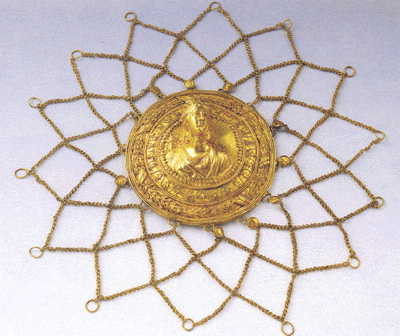Importance of Jewelry in Ancient Greece
by Lisa Bloomingdale
(Although some of it was probably plagiarized.)
In Sophocles’ Oedipus and the King, the most memorable artifact to be found is the brooch of Jocasta, Oedipus’ mother. This beautiful piece of Greek jewelry decorating Jocasta’s garments exhibited isolated figures or religious, mythological, or heroic scenes. However, the accoutrement also became the very weapon which blinded Oedipus for life. After discovering that he killed his father and married his mother, he sees no way out but to blind himself in shame. Oedipus removed the brooch from Jocasta’s dead body, for she had hanged herself after discovering her son’s true identity.
Jewelry was an integral part of Classic Greek culture accompanying man at the major stages of his life, including birth, marriage and important moments of expressing love, according to “Greek Jewelry: Five Thousand Years of Tradition.” Jewelry also accompanied man after life, being buried with the dead along with other personal objects. Because of this, many ancient pieces of jewelry are found in graves.
Many ancient Greeks began to adopt customs of Christianity, including the dedication of fine jewelry to the gods in order to thank them or to seek their protection. This practice of votive offerings to the deities soon replaced the burying of personal objects with the dead. (Greek Jewelry…) Although Sophocles did not write about Jocasta’s brooch being offered up to the gods, it certainly followed her to her death.
The history of the brooch is closely tied together with the history of jewelry making in general. Because gold was not readily available, jewelry was relatively rare in Classical Greece. According to www.allygirl.com, jewelry produced in ancient Attica and the Peloponnese shows evidence of strong Oriental stylistic influence. However, this style only lasted a few centuries. The Ionic style soon became popular, which took the place of the Oriental war scenes and animals.
The Ionic style of jewelry making was focused exclusively on the human figure. “These included naked riders on galloping horses; seated and standing maidens, depicted both with clothes and naked; and deities and mythological figures” (AllyGirl). The models of the human figure on jewelry were closely related to the ideals of beauty found in classic Greek sculpture. Ancient Greek jewelry was simply a way to display the magnificence of sculpture in miniature. Other jewelry in ancient Greece exhibited the motif of a serpent coiled in a double spiral, copied from Hellinistic models, according to www.allygirl.com. This was frequently used for bracelets, rings, arm bands, and earrings.
In was not long after that the use of colored stones came into play in jewelry making. Stones such as topazes, emeralds, rubies, pearls, and sapphires enhanced the beauty of ancient Greek jewelry. This is also when brooches became most popular among leaders of the ancient world. So it was not unusual to find a woman of power such as Jocasta flaunting the latest rage in royalty.
Jewelry has represented Greek culture since the beginning of civilization, and it is still an important part of Greek society today. Current makers of jewelry draw inspiration from the ancient culture of Greece. Depictions of Aphrodite’s girdle, Achilles’ shield, and other epic symbols are displayed in museums, kept safe in family chests, and worn proudly upon the chests of Greek women.

Works Cited
“Greek Jewelry: Five Thousand Years of Tradition.” The Hellenic Silver- and Goldsmith Center. http://www.addgr.com/jewel/elka/.
“History of Jewelry Design.” Ally Girl. http://www.allygirl.com/html/jewelry_history.html.
Grade: dunno yet
[Home]
